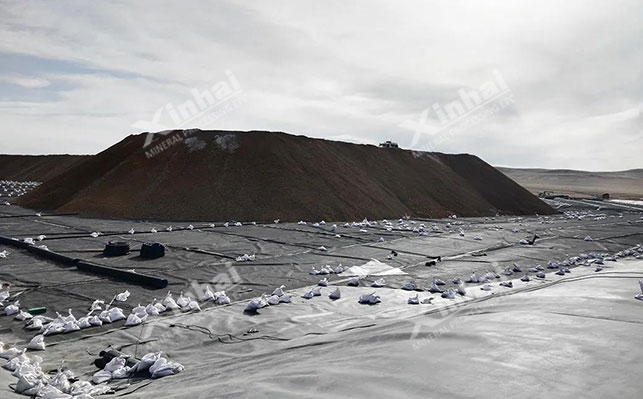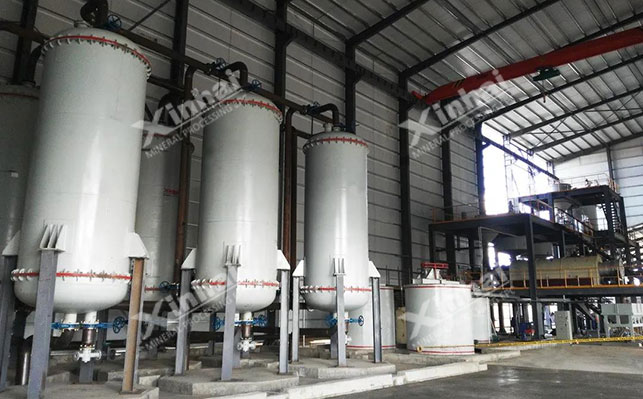The mined low-grade gold bearing ore or the waste ore mined in the early stage of the old ore is directly transported to the heap leaching site heap ore-forming heap or crushed and then transported to the heap leaching site heap ore-forming heap, and then the cyanide leaching agent is sprayed on the surface of the heap. The leaching agent is evenly percolated from top to bottom through the fixed heap, so that gold and silver enter the leaching solution. The principle process of percolation cyanidation heap leaching mainly includes ore preparation, construction of heap leaching plant, heap building, percolation leaching, washing and gold and silver recovery.
Gold bearing ores used for heap leaching are usually crushed first, and the crushing particle size depends on the ore property and the gold particle embedding characteristics. Generally speaking, the finer the ore particle size of heap leaching, the looser and porous the ore structure, and the higher the gold and silver leaching rate during cyanide heap leaching. However, the finer the particle size of heap leaching ore is, the smaller the infiltration rate during heap leaching is, and even the percolation leaching process cannot be carried out. Therefore, generally, during percolation cyanidation heap leaching, the ore can be crushed to less than 10mm, and when the mud content of the ore is small, the ore can be crushed to less than 3mm.

The percolation heap leaching site can be located on a hillside, valley or flat ground, and generally requires a slope of 3% - 5%. After the ground is cleaned and leveled, anti-seepage treatment should be carried out. Anti seepage materials can be tailings mixed with clay, asphalt, reinforced concrete, rubber plate or plastic film. If the ground is compacted or tamped first, polyethylene plastic film or high-strength polyethylene sheet (about 3mm thick) is paved on it, or linoleum paper or artificial felt is paved on it. It is required that the anti-seepage layer should not leak liquid and can withstand the pressure of the ore pile. In order to protect the impervious layer, fine-grained waste rock and coarse-grained waste rock with a thickness of 0.5 ~ 2.0m are often paved under the cushion, and then low-grade gold ore is transported to the heap leaching site by trucks and mining trucks for stacking.
In order to protect the ore heap, flood drainage ditches should be set around the heap leaching site to prevent floods from entering the ore heap. In order to collect the leachate, a collecting ditch is set in the heap leaching plant. The liquid collecting ditch is generally an open ditch lined with plastic plates, and a corresponding sedimentation tank is set to settle the slime, so that the precious liquid entering the precious liquid tank is a clear solution.
The heap leaching site can be used for many times or only once. The cushion of the heap leaching plant used once can be paved with a layer of clay with a thickness of about 0.5m on the compacted foundation, and then sprayed with sodium carbonate solution after compaction to enhance its anti-seepage performance.

Common stacking machines include trucks, bulldozers (crawler), cranes and belt conveyors. Stacking methods include multi stacking method, multi-layer method, slope method and hoisting method.
① Multi stack method
First, use belt conveyor to pile the ore into many ore piles with a height of about 6m, and then use bulldozer to level it (as shown in Figure 8-18). When the belt conveyor builds the pile, it will produce particle size segregation, the coarse particles will roll to the edge of the pile, and the surface ore will be crushed and compacted by the bulldozer. Therefore, trench flow will occur during percolation cyanidation leaching. At the same time, with the flow of the leaching solution, the deposit of slime in the ore heap is easy to block the pores, making it difficult for the solution to percolate from the inside of the ore heap and easy to flow through the coarse-grained area at the edge of the ore heap. Sometimes, it will even burst the slope of the ore heap, making the heap leaching uneven and reducing the leaching rate of gold.
② Multilayer method
Build a pile with trucks or loaders, pile a layer of ore, and then bulldoze it with bulldozers. Pile it up layer by layer until it reaches the required height of the ore pile (as shown in Figure 8-19). This stacking method can reduce the particle size segregation phenomenon and make the ore particle size in the ore pile more uniform, but each layer of ore can be crushed and compacted by trucks and bulldozers, and the permeability of the ore pile is poor.
③ Slope method
First, build a slope conveyor road with waste rocks for truck ore transportation. The slope is 0.6 ~ 0.9m higher than the ore heap. Dump the ore to be leached to both sides of the slope with trucks, and then push it to both sides with bulldozers (as shown in Figure 8-20). When stacking with this method, the truck will not crush and compact the ore, and the pressure of the bulldozer is smaller than that of the truck, which has little impact on the porosity of the ore pile. After the ore pile is built, the slope of waste rock shall be leveled and the waste rock shall be loosened with a scarifier. This pile building method can obtain ore piles with uniform porosity, but it covers a large area.
④ Hoisting method
The ore is piled by bridge crane and leveled by electric rake. This method can eliminate the compaction of ore pile by ore conveying machinery, and the ore pile has good percolation, which can make the leaching solution pass through the ore pile more evenly, and the leaching rate is higher. However, this method requires the erection of crane tracks, with large capital investment and slow stacking speed.
After the ore heap is built, the ore heap can be washed with saturated lime water first. When the pH value of the washing solution is close to 10, it can be sent into cyanide solution for infiltration. The cyanide leaching agent is pumped to the branch pipe on the surface of the ore heap through the underground pipeline, and then the leaching agent is evenly sprayed on the surface of the ore heap through the sprinkler to make it percolate evenly and leach gold and silver through the ore heap. The commonly used sprinklers include sway, ejector and drip. The structure of the sprinkler should be simple, easy to maintain, with large spraying radius, uniform spraying, and coarse spraying droplets to reduce evaporation and reduce the heat loss of water. The solution supply in the leaching process shall be uniform and stable, and the spray speed of the solution is usually 1.4 ~ 3.4ml/ (M2 · s).
After percolation cyanidation heap leaching, wash it with fresh water for several times. If time permits, the washing liquid should be drained after each washing to wash the next time, so as to improve the washing rate. The total amount of water used for washing depends on the evaporation loss of washing water and the water content of tailings.
The gold content in the precious liquid obtained by percolation cyanidation heap leaching is low. Generally, activated carbon adsorption or zinc replacement method can be used to recover gold and silver, but activated carbon adsorption method is often used to obtain a higher recovery rate of gold and silver. Generally, 4 ~ 5 activated carbon columns are used to enrich gold and silver, and the desorbed precious liquid is sent to electrowinning, smelting electrowinning gold powder to obtain finished gold. The lean solution after gold and silver removal is returned to the ore heap for percolation and leaching after adjusting the cyanide concentration and pH value.
The waste ore heap after heap leaching is loaded into trucks by the front loader and sent to the tailings yard for stacking, which can be rebuilt and infiltrated on the heap leaching yard. The waste rock after heap leaching in the heap leaching site for one-time use does not need to be transported away and becomes a permanent waste rock heap.